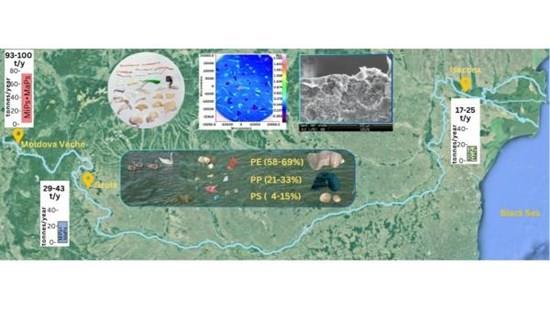(MENAFN- Newsfile Corp)
Targu Bujor, Romania--(Newsfile Corp. - October 13, 2024) - The Romanian Global Water Partnership Association (GWP RO) and "Mai Mult Verde" NGO associations, in collaboration with national and international partners, announce the completion of the first detailed spatio-temporal study on the transport of microplastics (MiPs) and macroplastics (MaPs) in the Romanian sector of the Danube.

GWP Romania Announces First Spatio-Temporal Study Into Danube Microplastics
To view an enhanced version of this graphic, please visit:
The study is available at #38;utm_medium=email&utm_campaign=oa_20240901&utm_content=10.1186%2Fs12302-024-00969-8
Recently published in the international scientific journal Environmental Sciences Europe, the study marks an important step in understanding plastic pollution in Europe's second-longest river.
STUDY OBJECTIVE
Plastic pollution in rivers and oceans is one of the greatest ecological challenges of the 21st century. Despite global research efforts, the lack of standardized regulations has complicated the comparison of data between studies. In this context, researchers from the "Dunarea de Jos" University, REXDAN Research Infrastructure, have conducted an innovative study focused on the transport of microplastics in the Romanian sector of the Danube, from its entry point into the country (Moldova Veche) to the formation of the Danube Delta (Isaccea).
METHODOLOGY AND STUDY LOCATIONS
The study was carried out over five seasons, from spring 2022 to spring 2023, using a multi-point active sampling methodology proposed for standardization at the European level.
A total of 135 sediment samples were collected from three different depths, from the water's surface to near the riverbed, at three key sections: Moldova Veche, Gruia and Isaccea.
RESULTS
The study estimated the annual transport of 46-51 tons of microplastics and 93-100 tons of total plastic (including meso- and macroplastics) at Moldova Veche under normal hydrological conditions.
Gruia and Isaccea recorded significantly lower values, approximately 4-5 times les, suggesting a decrease in the amount of plastic transported as the river moves towards the Danube Delta.
Polyethylene (PE) and polypropylene (PP) were identified as the main components of microplastics, representing between 58% and 69% of the total particle analyzed. The study also revealed that microplastics were mostly polygonal fragments, foils, and spheres of different colors, while meso- and macroplastics consisted of semi-transparent and/or porous foil fragments, fibers, and fiber conglomerates.
ENVIRONMENT IMPACT & CONTRIBUTIONS
This study provides the first complete set of data on the transport of microplastics in the Romanian sector of the Danube, offering crucial information for a comprehensive assessment of microplastic transport and accumulation in the Danube's watershed, the largest in Europe. The research also contributes to European efforts to regulate and standardize sediment sampling methods in large rivers.
Advanced near-infrared (NIR) imaging and scanning electron microscopy (SEM-EDX) techniques were used to investigate the microstructural degradation of plastic particles at the micro- and nanometric scales. These analyses identified the presence of various (chemo)sorbed components, including minerals and heavy metals, suggesting a significant impact on the aquatic ecosystem.
FUTURE PERSPECTIVES
Researchers emphasize the need for continued investigations, including during flood periods, and the expansions of sampling locations for further validation. These studies are essential to fully understand the dynamics of microplastic and macroplastic pollution and to develop effective solutions for reducing this type of pollution.
ABOUT THE RESEARCH GROUP
The study presented in this paper was carried out by the project "Dunărea la Raport/Reporting on the Danube", implemented by the Romanian Global Water Partnership Association (GWP-ROMANIA) and "Mai Mult Verde" NGO associations, within the framework of "Cu Apele Curate"/"Clean Waters" program, supported by Lidl Romania.
All these parties are greatly acknowledged.
The team is grateful to Prof. Dr. Chem. Viorica D. Mușat for her significant contribution, particularly in conceptualization, writing, reviewing and editing, visualization, and supervision. Her diligent work in reading and analyzing numerous articles greatly shaped the scientific foundation of this research.
Dr. Martin Hinterleitner is acknowledged for contributing to the measurement team during S3 sampling season (autumn 2022).
Director Dr. Eng. Angela Stela Ivan (Galati Lower Danube River Administration) and Dr. Eng. Ioan Mateescu (ROMEXIM SRL București) are acknowledged for key contributions in providing the logistic support during the sampling of suspended alluvium and the selection of the sampling locations on the Romanian sector of the Danube.
ABOUT GLOBAL WATER PARTNERSHIP ROMANIA
Part of the Global Water Partnership network, GWP Romania promotes the sustainable management of Romania's water resources at all levels. Fostering partnerships with both private and public actors and stakeholders, GWP Romania is committed to the development and promotion of ecologically sustainable policies based on cutting-edge research, with the goal of protecting water resources for the benefit of current and future generations.
For more information, visit
Contact Info:
Name: Ionut Procop
Email: ...
Organization: GWP Romania - Global Water Partnership România
Address: Strada Roşiori nr. 4, Târgu Bujor, Județul Galați 805200, Romania
Website: /
To view the source version of this press release, please visit
SOURCE: Plentisoft
MENAFN14102024004218003983ID1108774924
Legal Disclaimer:
MENAFN provides the information “as is” without warranty of any kind. We do not accept any responsibility or liability for the accuracy, content, images, videos, licenses, completeness, legality, or reliability of the information contained in this article. If you have any complaints or copyright issues related to this article, kindly contact the provider above.